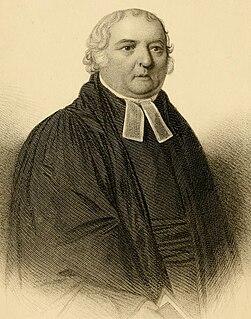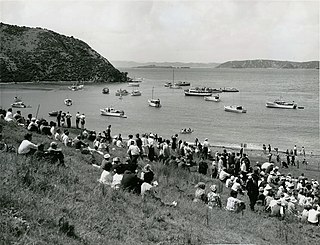Related Research Articles

Ngāpuhi is a Māori iwi associated with the Northland region of New Zealand and centred in the Hokianga, the Bay of Islands, and Whangarei.

Samuel Marsden was an English-born priest of the Church of England in Australia and a prominent member of the Church Missionary Society, believed to have introduced Christianity to New Zealand. Marsden was a prominent figure in early New South Wales and Australian history, partly through his ecclesiastical offices as the colony's senior Church of England cleric and as a pioneer of the Australian wool industry, but also for his employment of convicts for farming and his actions as a magistrate at Parramatta, both of which attracted contemporary criticism.

Thomas Kendall was a New Zealand missionary, recorder of the Māori language, schoolmaster, arms dealer, and Pākehā Māori.

Endodontidae is a taxonomic family of very small air-breathing land snails and slugs, terrestrial pulmonate gastropod mollusks in the superfamily Punctoidea.
Ruatara koarana is a species of small air-breathing land snail, a terrestrial pulmonate gastropod mollusk in the family Charopidae. This species is endemic to French Polynesia.
Ruatara oparica is a species of small air-breathing land snail, a terrestrial pulmonate gastropod mollusk in the family Charopidae. This species is endemic to French Polynesia.
The first Christian mission is established at Rangihoua. The Hansen family, the first non-missionary family also settles there. Samuel Marsden explores the Hauraki Gulf and travels to within sight of Tauranga Harbour. The first book in Māori is published in Sydney. The first European is born in New Zealand.
With the purchase of a vessel by Samuel Marsden for use by the Church Missionary Society at the beginning of the year the establishment of a mission in New Zealand is at last possible. After a preliminary scouting trip Marsden and the missionaries arrive at the end of the year and the first mission is begun at Rangihoua Bay in the Bay of Islands.
By the end of the year reports from London regarding Napoleon's retreat from Moscow, and from the Bay of Islands regarding the hospitality of the Māori, encourage Samuel Marsden into thinking the time for the establishment of a Christian mission to New Zealand is now imminent.
There are still far fewer ships visiting New Zealand than before 1810. This is due to the economic depression which started in New South Wales in 1810 and continues until 1815. The concern that the Boyd massacre might be repeated abates somewhat as a number of reports that it was provoked reach Port Jackson. As more ships resume visits to the Bay of Islands they consistently report that they are well treated.
There is a drastic decline in the number of ships visiting New Zealand from the previous year. An economic depression starts in New South Wales as a result of the escalation of war in Europe and the consequent reduction in the number of convicts being transported. In March news of the Boyd massacre reaches Port Jackson and a punitive expedition is sent to New Zealand and bombards the village of the incorrectly blamed chief, Te Pahi. After this the few whaling ships that later head for New Zealand usually prefer to avoid landing, especially in the Bay of Islands.
Foveaux Strait is the centre of attention for sealing ships. Sealing gangs are dropped along the coast from southern Fiordland to Otago Harbour and on Stewart Island/Rakiura. The Bay of Islands is sometimes on the journey to or from Port Jackson. The Chatham Islands are also visited. A few whalers also operate around New Zealand; some also collect timber from Bay of Islands.
As sealing at Bass Strait and the Antipodes Islands declines, Foveaux Strait becomes the focus for sealers from the middle of the year. The Bounty and Auckland Islands are also visited. Whaling is carried out on the east coast of New Zealand with the Bay of Islands being the usual port of call for provisioning. As many as nine ships whaling together for months at a time can occur. The behaviour of the whalers at the Bay of Islands is again commented on unfavourably, this time by a former missionary on one of the whaling ships. There are also a number of vessels collecting sandalwood from Tonga or Fiji; the majority call at the Bay of Islands en route.
Sealing continues at Bass Strait and the Antipodes Islands. At the end of the year there is a new sealing rush to the Bounty and Auckland Islands. Few sealers, if any, are known to have visited the Foveaux Strait area at this time, although this may be due in part to the secrecy of the captains and owners in reporting where they operate and/or the existence of the Strait not yet being widely known. Whaling continues off the east coast of the North Island. Ships are now visiting the Bay of Islands on a reasonably regular basis. The first reports about the poor behaviour of ships crews are sent to the Church Missionary Society in London.
Sealing continues at Bass Strait but declines at Dusky Sound which is still used for provisioning. There is a new rush to the Antipodes Islands. The existence of Foveaux Strait is not reported in Port Jackson until early the following year so sealers are still travelling via the south of Stewart Island/Rakiura which some also visit. At Stewart Island/Rakiura, and its smaller surrounding islands, the sealers often encounter Māori which they have not done at all at Dusky Sound. As many as 16 whalers are operating around the north of New Zealand, occasionally visiting the Bay of Islands and taking an increasing number of Māori on board as crew.
Santa Anna was a Spanish brig that a British privateer captured in 1806. Her new owners then employed Santa Anna as a whaler. She wrecked in the Straits of Timor in 1811.
Ruatara may refer to:
Ruatara was a chief of the Ngāpuhi iwi (tribe) in New Zealand. He introduced European crops to New Zealand and was host to the first Christian missionary, Samuel Marsden.

Rangihoua Bay is a bay at the southern end of the Purerua Peninsula, on the north-west shore of the Bay of Islands in Northland, New Zealand. It is 10 km north across the Bay of Islands from Russell and 12 km north from Paihia. By road it is 32 km from Kerikeri.
Ann was built in Batavia in 1797. How she came into British hands is currently unclear. She first appeared in a register in 1802, and thereafter made a voyage for the British East India Company (EIC). In 1809 she made a voyage transporting convicts to New South Wales for the British government. On her return voyage she carried cargo for the EIC from Calcutta to London. She then became a West Indiaman, trading between London and Jamaica. Later she traded with Australia and India, and is last listed c.1865.
References
| This Charopidae-related article is a stub. You can help Wikipedia by expanding it. |